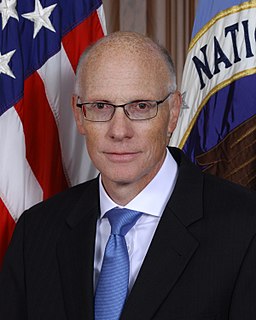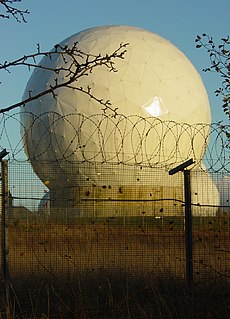
ECHELON, originally a secret government code name, is a surveillance program operated by the US with the aid of four other signatory nations to the UKUSA Security Agreement: Australia, Canada, New Zealand and the United Kingdom, also known as the Five Eyes.

The National Security Agency (NSA) is a national-level intelligence agency of the United States Department of Defense, under the authority of the Director of National Intelligence. The NSA is responsible for global monitoring, collection, and processing of information and data for foreign and domestic intelligence and counterintelligence purposes, specializing in a discipline known as signals intelligence (SIGINT). The NSA is also tasked with the protection of U.S. communications networks and information systems. The NSA relies on a variety of measures to accomplish its mission, the majority of which are clandestine.

Lew Allen, Jr. was a United States Air Force four-star general who served as the tenth Chief of Staff of the United States Air Force. As the chief of staff, Allen served as the senior uniformed Air Force officer responsible for the organization, training, and equipping of 750,000 active duty Air Force, Air National Guard, Air Force Reserve, and civilian personnel serving in the United States and overseas. As a member of the Joint Chiefs of Staff, he and the other service chiefs function(ed) as the military advisers to the Secretary of Defense, the National Security Council, and the President.
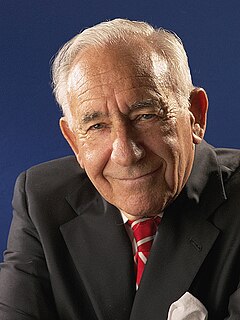
David Kahn is a US historian, journalist and writer. He has written extensively on the history of cryptography and military intelligence.

The Central Security Service (CSS) is an agency of the United States Department of Defense, which was established in 1972 to integrate the National Security Agency (NSA) and the Service Cryptologic Elements (SCE) of the United States Armed Forces in the field of signals intelligence, cryptology and information assurance at the tactical level. In 2002, the CSS had about 25,000 uniformed members.

William Bolding Black, Jr. is a former Deputy Director of the National Security Agency.

The Puzzle Palace is a book written by James Bamford and published in 1982. It is the first major, popular work devoted entirely to the history and workings of the National Security Agency (NSA), a United States intelligence organization. The title refers to a nickname for the NSA, which is headquartered in Fort Meade, Maryland. In addition to describing the role of the NSA and explaining how it was organized, the book exposed details of a massive eavesdropping operation called Operation Shamrock. According to security expert Bruce Schneier, the book was popular within the NSA itself, as "the agency's secrecy prevents its employees from knowing much about their own history".

James Bamford is an American bestselling author, journalist and documentary producer widely noted for his writing about United States intelligence agencies, especially the National Security Agency (NSA). The New York Times has called him "the nation's premier journalist on the subject of the National Security Agency" and in a lengthy profile The New Yorker named him "the NSA's chief chronicler." Bamford has taught at the University of California, Berkeley as a distinguished visiting professor and has written for The New York Times Magazine, The Atlantic, Harper's, and many other publications. In 2006, he won the National Magazine Award for Reporting, the highest award in the magazine industry, for his writing on the war in Iraq published in Rolling Stone. He is also an Emmy nominated documentary producer for PBS and spent a decade as the Washington investigative producer for ABC's World News Tonight. In 2015 he became the national security columnist for Foreign Policy Magazine and he also writes for The New Republic. His most recent book, The Shadow Factory: The Ultra-Secret NSA From 9/11 to the Eavesdropping on America, became a New York Times bestseller and was named by The Washington Post as one of "The Best Books of the Year." It is the third in a trilogy by Bamford on the NSA, following The Puzzle Palace (1982) and Body of Secrets (2001), also New York Times bestsellers.

Keith Brian Alexander is a retired four-star general of the United States Army who served as director of the National Security Agency (DIRNSA), chief of the Central Security Service (CHCSS) and commander of the United States Cyber Command. He previously served as Deputy Chief of Staff, G-2, U.S. Army from 2003 to 2005. He assumed the positions of Director, National Security Agency and Chief, Central Security Service on August 1, 2005 and the additional duties as Commander, United States Cyber Command on May 21, 2010.

Michael Vincent Hayden is a retired United States Air Force four-star general and former Director of the National Security Agency, Principal Deputy Director of National Intelligence, and Director of the Central Intelligence Agency. Hayden currently co-chairs the Bipartisan Policy Center's Electric Grid Cyber Security Initiative. In 2017, Hayden became a national security analyst for CNN.
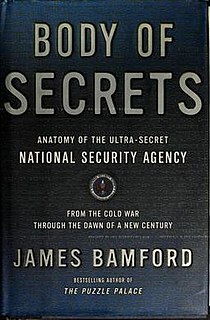
Body of Secrets: Anatomy of the Ultra-Secret National Security Agency is a book by James Bamford about the NSA and its operations. It also covers the history of espionage in the United States from uses of the Fulton surface-to-air recovery system to retrieve personnel on Arctic Ocean drift stations to Operation Northwoods, a declassified US military plan that Bamford describes as a "secret and bloody war of terrorism against their own country in order to trick the American public into supporting an ill-conceived war they intended to launch against Cuba."
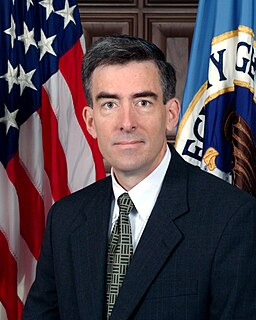
John Chris Inglis, also known as Chris Inglis, is a former Deputy Director of the National Security Agency. He retired as Deputy Director on January 10, 2014.

James F. Sloan is a past Assistant Commandant for Intelligence and Criminal Investigations (CG-2) for the United States Coast Guard and head of Coast Guard Intelligence, having served in this capacity from 17 November 2003 to 27 February 2009. He was responsible for directing, coordinating, and overseeing intelligence and investigative operations and activities that support all U.S. Coast Guard mission objectives, the National Strategy for Homeland Security, and National Security objectives.
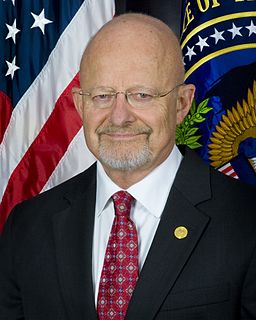
James Robert Clapper Jr. is a retired lieutenant general in the United States Air Force and is the former Director of National Intelligence. Clapper has held several key positions within the United States Intelligence Community. He served as director of the Defense Intelligence Agency (DIA) from 1992 until 1995. He was the first director of defense intelligence within the Office of the Director of National Intelligence and simultaneously the Under Secretary of Defense for Intelligence. He served as the director of the National Geospatial-Intelligence Agency (NGA) from September 2001 until June 2006.

Ann Zeilinger Caracristi was an American cryptanalyst, former Deputy Director of the National Security Agency, where she served at various positions over a 40-year career. She served as a member of the Secretary of Defense Joint Security Commission and President's Foreign Intelligence Advisory Board. She became the first woman at NSA to be promoted to GS-18 rank, in 1975, when she became the Chief of Research and Operations.
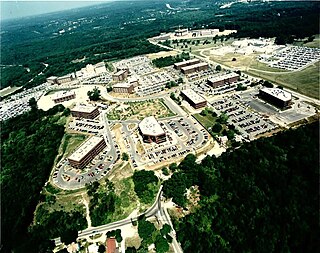
The Friendship Annex, also known as FANX or FANEX, is a National Security Agency (NSA) facility complex located in Linthicum, Maryland, near the Baltimore Washington International Airport (BWI). Established in the 1970s, the complex consists of multiple buildings and serves multiple roles as a cyber espionage station, electronic intelligence processing facility, and NSA Broadcast Network television studio. It is also the primary campus of the National Cryptologic School.

Robert Leo Prestel is an American intelligence official and mathematician who was Deputy Director of the National Security Agency from 1990 to 1994, during which time he was the highest ranking civilian in the agency. Prestel joined the NSA in 1962 and held many positions prior to being appointed as deputy director, including Director of Education and Training from Deputy Director for Research and Engineering. Among other positions Prestel has served in include trustee for the Institute for Defense Analyses and on the Board of Directors of WJ Communications. He currently serves as trustee emeritus of Institute for Defense Analyses.

Robert Ellett Rich was an American intelligence official who was Deputy Director of the National Security Agency from 1982 to 1986 during which time he was the highest ranking civilian in the agency, working on internal management. He was also a "far east expert".

Robert Edwin Drake was an American intelligence official who was Deputy Director of the National Security Agency from 1978 to 1980 during which time he was the highest ranking civilian in the agency.

Benson Kirk Buffham was an American intelligence official who was Deputy Director of the National Security Agency from 1978 to 1980 during which time he was the highest ranking civilian in the agency.

